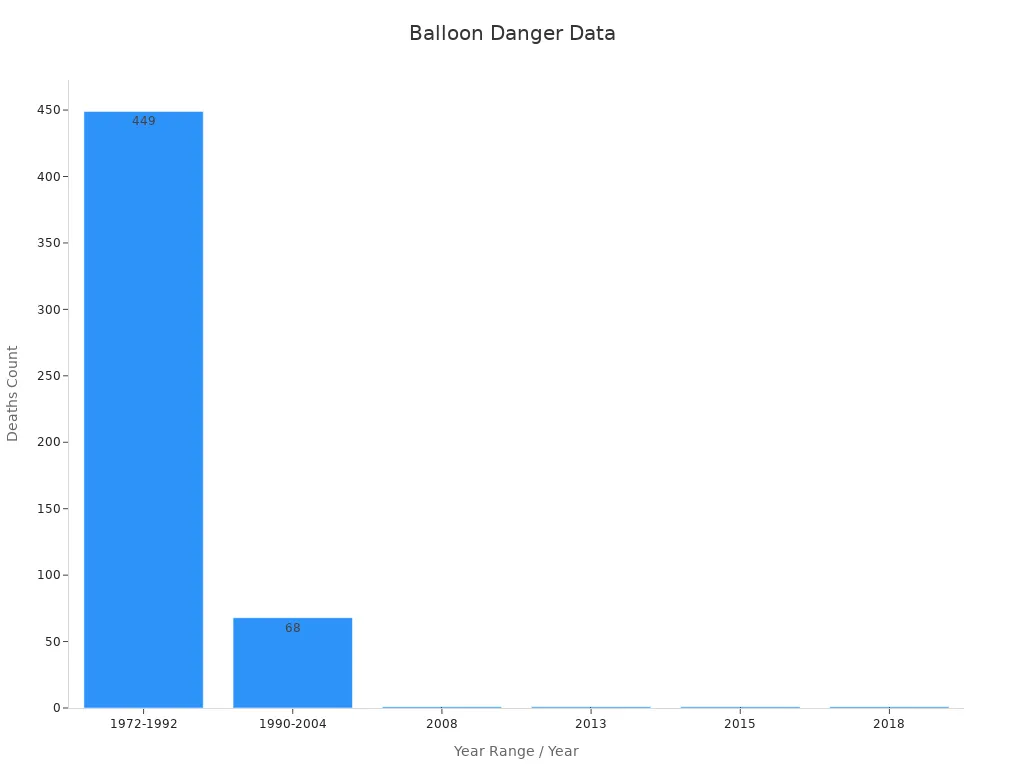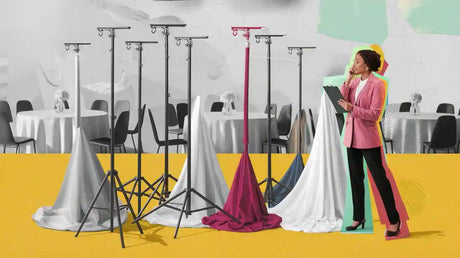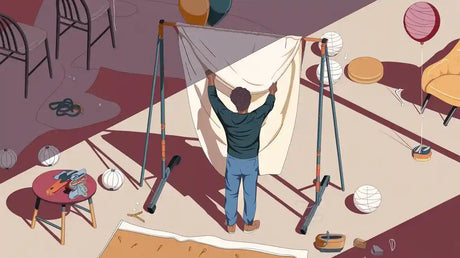
Balloons make parties fun, but they can be dangerous. Latex and balloons are a top cause of choking in kids. From 1973 to 1988, 121 U.S. kids died from choking on latex balloons. Parents should learn about these risks to keep kids safe.
Key Takeaways
Balloons can cause choking in kids under 8. Watch kids closely when they play with balloons to avoid accidents.
Some kids may be allergic to latex. If your child has itching or breathing problems, stay away from latex balloons and see a doctor.
Throw away broken or unused balloons right away. Teach kids how to handle balloons safely to protect them and the environment.
Understanding the Risks of Balloons and Children
Choking Hazard and Suffocation Risks
Balloons are a top cause of choking in kids under 8. If a child breathes in a balloon, it can block their throat. This can lead to suffocation. Uninflated balloons and broken pieces are very risky. These small parts can be swallowed or inhaled easily. They are unsafe for kids under 3 years old.
-
Past data shows how serious this problem is:
In 1989, 17 kids died from choking on balloons. By 1998, this dropped to 4 deaths.
Better labels and more supervision cut deaths by almost half.
Between 1985 and 1996, 98 kids died from balloon choking.
Parents should watch kids closely when balloons are around. Keep uninflated balloons out of their reach.
Latex Allergies in Children
Latex allergies are another big problem. Some kids may react badly to latex balloons. Reactions can range from itchy skin to trouble breathing. Signs include swelling, itching, or breathing problems. If your child has these symptoms, avoid latex items. Talk to a doctor right away. Use Mylar balloons instead to stay safe.
Other Dangers of Latex Balloons
Balloons can also pop suddenly and scare or hurt kids. Popped balloon pieces are choking hazards too. Data shows balloon-related deaths happen in all age groups:
Year |
Deaths |
Age Group |
Cause of Death |
|---|---|---|---|
1972-1992 |
449 |
Under 14 |
Choking on non-food products |
1990-2004 |
68 |
Children |
Choking due to latex balloons |
2008 |
1 |
5 years old |
Balloon stuck in airway |
2018 |
1 |
2 years old |
Fatally choked on a balloon |
2015 |
1 |
2 years old |
Choked while playing with balloon |
2013 |
1 |
10 years old |
Inhaled a balloon |

Knowing these dangers can help stop accidents. Throw away broken balloons right away. Teach kids about balloon safety to keep them safe.
Safety Guidelines for Parents
Watching Kids with Balloons
Always watch kids when they play with balloons. Supervision helps prevent choking and other accidents. Latex balloons cause the most toy-related deaths. Kids under 8 are at the greatest risk. Small balloon pieces can block a child’s throat. Keep uninflated balloons out of reach. Throw away broken balloons right away.
Mylar balloons are safer than latex ones. Use a pump to inflate balloons instead of blowing them up. This stops kids from accidentally inhaling balloons. Stay nearby and watch for any problems while they play.
Throwing Away Latex Balloons Safely
Dispose of latex balloons properly to avoid choking and pollution. Never leave broken balloons lying around. Throw them away immediately to keep kids safe. Campaigns like "Pin it and Bin It" teach safe disposal methods. Groups like PEBA help parents learn about balloon safety.
Laws also stress safe disposal. For example, Virginia banned releasing balloons in large numbers. This law helps protect the environment. By following these tips, you can keep kids and nature safe.
Evidence Type |
Details |
|---|---|
Law |
Virginia banned mass balloon releases to stop environmental harm. |
Education Campaign |
"Pin it and Bin It" teaches how to safely throw away balloons. |
Research |
Studies show balloon litter harms the environment over time. |
Reading Balloon Safety Warnings
Check balloon labels for safety warnings before buying. Labels explain risks and how to avoid accidents. For example, they say balloons aren’t safe for kids under 3. They also warn about choking on small balloon parts.
Some labels give extra advice, like not inhaling helium or using metallic ribbons. Always read these warnings carefully. Following these rules can make playtime safer for your child.
Warning Details |
|---|
Not for kids under 3 years old |
Choking risk: Kids under 8 can choke on small balloon parts |
Keep uninflated balloons away from kids |
Broken balloons must be thrown away immediately |
Don’t inhale helium. It can stop oxygen and cause serious harm or death |
Don’t release balloons outside or near power lines |
Avoid metallic ribbons |
Use a counterweight with balloons |
Ribbons can cause choking or tangling injuries |
What to Do in a Choking Emergency

Immediate Steps to Take
If a child chokes on a balloon, act fast to help. Stay calm and check what’s happening. If they are coughing or making noise, let them keep coughing. This can help push the object out naturally. But if they can’t breathe, talk, or cry, act right away.
Use the Heimlich maneuver to clear the blockage. Stand behind the child, place your hands above their belly button, and push inward and upward quickly. This method works in 70% of choking cases. For babies under one year old, use back blows and chest thrusts. Lay the baby face down on your arm, give five firm back blows between their shoulders, then turn them over and give five chest thrusts.
Keep uninflated balloons and broken pieces away from kids. Always watch them during play to prevent accidents.
Tip: Learn first aid skills to handle emergencies. Many groups offer free or cheap CPR and first aid classes.
When to Seek Medical Help
Even if the balloon is removed, see a doctor right away. Choking can cause swelling or injuries that block breathing later. If the child faints or seems very distressed, call 911 immediately. Paramedics can give advanced care to keep the child safe.
Afterward, visit a pediatrician to check for any problems. They can examine the child and suggest ways to avoid future accidents.
Note: Stopping accidents is better than fixing them. Teach kids about balloon safety and watch them while they play.
Environmental Safety and Latex Balloons
Balloon Litter and Its Impact
Latex balloons might look fun, but they harm nature. When balloons are thrown away carelessly or released, they become litter. In five years, volunteers picked up over 4,916 balloon pieces. More than half of these were found on beaches. This shows how big the problem is. Balloons take hundreds of years to break down, polluting for a long time.
Wildlife suffers greatly from balloon waste. Sea animals often eat balloons, thinking they are food. This can block their stomachs or make them starve. Balloon pieces can also trap animals, stopping them from moving or escaping predators. Balloons even cause power problems. About 20% of power outages happen because of balloons hitting power lines. These facts show why we must stop balloon litter to save nature and animals.
Evidence Type |
Description |
|---|---|
Balloon Litter |
Over 4,916 pieces cleaned up in five years, with most found on beaches. |
Biodegradation |
Balloons take hundreds of years to break down. |
Marine Life Impact |
Animals ingest balloons, causing starvation and blockages. |
Entanglement Risk |
Balloon debris entangles animals, hindering their survival. |
Power Outages |
Balloons cause up to 20% of power outages by contacting power lines. |
Responsible Balloon Use for Parents
Parents can help reduce balloon pollution by being careful. Don’t release balloons outside because they turn into litter. Use balloons indoors where you can throw them away properly. Mylar balloons are a safer option. They are less harmful to animals and easier to recycle.
Some groups and events are working to use balloons responsibly. For example, the Australian Football League Grand Final stopped using helium balloons to protect the environment. In New South Wales, laws now ban balloon decorations that could hurt sea life. These actions show how learning and rules can change habits.
Parents can teach kids about balloon safety and caring for the planet. Watch kids when they play with balloons to ensure safe disposal. Small changes like these can protect both your kids and the Earth.
Latex balloons are fun but can be dangerous for kids. Choking and allergies are common problems with balloons. Parents can help by watching kids during play and throwing away balloons safely. Being ready for emergencies is also important. Knowing these risks can save lives. Using balloons responsibly also helps protect nature from litter.
Statistic Description |
Percentage |
|---|---|
Accidents involving pilots with 15 or fewer hours in 90 days |
|
Accidents occurring during the landing phase |
79% |
Accidents involving pilots with the highest achievement award |
54% |
These numbers show why safety matters. Parents must ensure balloons are both fun and safe for kids.
FAQ
What age is safe for children to play with latex balloons?
Children under 8 years old face higher risks with latex balloons. Always supervise younger children to ensure their safety during play.
Are Mylar balloons safer than latex balloons?
Yes, Mylar balloons are safer. They don’t pose the same choking risks or cause latex allergies, making them a better choice for children.
How can I teach my child about balloon safety?
Explain the dangers of uninflated or broken balloons. Show them how to handle balloons responsibly and remind them not to put balloons in their mouths.








